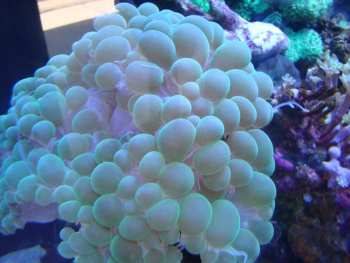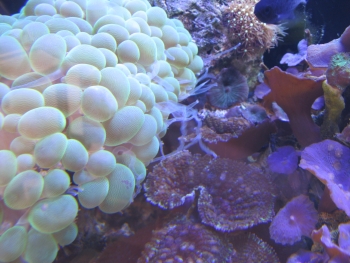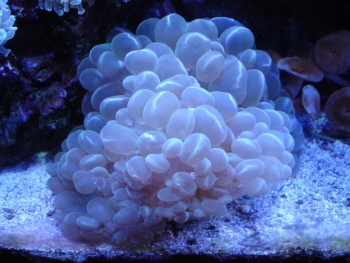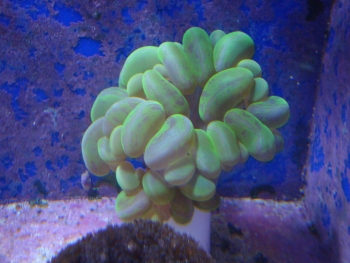
By Bob Goemans

Known by many names, e.g., Bubble Coral, Bladder Coral, Grape Coral, Octobubble Coral, or Pearl Coral, this stony coral (Plerogyra sinuosa) is one of the all time favorites among most reef aquarists.
Even though there are two other described species (and possibly some yet undescribed) in this genus, i.e., P. lichtensteini (usually called Pearl Coral) and P. simplex (sometimes referred to as ‘branching’ Bubble Coral), they are ‘rarely’ ever seen in the trade.
And once you’ve seen a bubble coral, there’s no doubt its common names appear quite fitting as its skeleton mass is topped by an array of water filled bubble-shaped polyps (vesicles). Add to its eye-catching appearance the facts they are very hardy and easy to care for, and it becomes a favorite of most reef aquarists.

Bubble Corals hail from the Western and Indo-Pacific Oceans and also the Red Sea, and are in the Phylum Cnidaria (Stony Coral), Order Scleractinia, Family Caryophylliidae, and are in the Genus Plerogyra, pronounced ‘Plee-roh-jai-uh.’
They are usually found in protected shaded areas that receive gentle water movement. In these areas, e.g., lower reef slopes, under overhangs and cave walls, they are often found in a vertical position. And when found in moderately lit areas, the waters are sometimes quite murky/turbid.
Its skeleton develops a somewhat flattened, yet continuous and unbranched wall of fused vertical plates (septa). It is topped with a tissue mass that has water filled bubble-shaped polyps, which can develop slightly different shapes and colors. Surface areas of the bubbles contain zooxanthellae and the bubbles expand during the day and mostly retract at night. At night, the coral displays long sweeper tentacles, sometimes 3 or 4 inches (7.5 - 10 cm) in length that can sting downstream neighbors within reach. They are also capable of stinging human flesh, so be forewarned.

Bubbles are usually .5 to 1.0 inch (1 - 2.5 cm) in length, sometimes larger. Tapered feeding tentacles emerge at night to capture plankton. It should be noted the short tentacles associated with the bubbles during the day do not contain stinging cells, yet the sweepers extended during the night do contain stinging nematocysts. Specimens over 3 feet (1 m) across have been seen in the wild.
Where most aquarists are concerned, and as discussed here, there is only one species of interest - Plerogyra sinuosa (Dana, 1846). The most common colors are white or light tan, yet some specimens exhibit a pale green or pink tinge depending upon area of origin. Those with colored tints appear to require slightly better lighting than white or tan specimens. Some bubbles have a fingerprint pattern on their surface, or exhibit a shimmering band down the middle surface area of the bubble and these are called Cat Eye Bubble Corals.

It’s thought that the size of the bubble regulates the amount of light its zooxanthellae receive, since this coral does not photoadapt, i.e., adjusts its level of photosynthetic cells to match light intensity. It simply regulates how much light it sees with bubble size. Therefore proper placement in the aquarium is extremely important. Generally, most prefer low to medium light, such as from fluorescent lamps. I would not recommend ‘strong’ direct light from metal halide lamps. And, since its impossible to know exactly the lighting conditions from where the coral was collected, and the fact it has had inadequate lighting during shipment, its always wise to first place it in your aquarium in a low light area. This prevents ‘light shock,’ which could cause the loss of the coral. Then, as it adapts over the coming weeks, move it to a brighter area if so desired. Just keep in mind, haste makes waste when moving these corals too fast to much brighter areas.

Even though bubble corals are a photosynthetic stony coral, its also a suspension feeder and accepts zooplankton/meaty type foods when its feeding tentacles are displayed. When I feed my aquarium, if feeding tentacles are displayed, I use a small turkey baster and directly dose the polyps/tentacles with meaty foodstuffs, e.g., fortified brine shrimp, mysis, rotifers, diced clam/marine fish flesh/shrimp flesh, and/or products containing Cyclop-eeze. Nevertheless, I have often found overfeeding or feeding with large pieces of marine flesh to cause the specimen to go through odd shape changes that seemed to affect its longevity. Therefore, if the decision is made to feed, do so sparingly, e.g., twice monthly. Keep in mind if the water movement is too swift, the bubbles will not fully expand, detracting from the natural nourishment provided by the zooxanthellae on the surface of each bubble. And it’s also possible a strong current will separate the corals flesh from its skeleton.
Even though there has been recorded happenings of sexual reproduction of some stony corals in aquaria, I do not known of it happening with bubble corals. However, it’s still possible for a clone of the specimen to form in the aquarium. In fact, there are two ways in which this can happen, and the first is called ‘budding.’ This occurs when a small growth or ‘bud’ appears on the animal’s flesh, usually near its lower edges. Over time, this bud develops a tiny skeleton and from the weight of it’s forming skeleton, drops off the parent. If cared for, this can now develop into an exact copy of the adult coral. In fact, I’ve had a similar ‘budding’ occasion with a yellow leather coral where a few dozen buds formed on its backside. Some dropped off and were placed in secure areas in the aquarium where they began to develop into full replicas of its parent.
Another form of cloning happens when the tissue of the parent begins to spread onto a piece of substrate that the parent is touching. As the tissue spreads onto to the adjacent substrate, a skeleton begins to form inside the spreading tissue and a new bubble coral is born! Unfortunately, both of these reproduction methods are quite rare happenings.
When shopping for a bubble coral, be aware the animal's septa, i.e., the upright large blade-like structures that extend above the corallite walls, are quite sharp and somewhat thin. Therefore handling during collection and/or shipping can easily damage this skeleton material and its associated tissue. It's always better to select a specimen that looks healthy and shows no signs of damage or has any tissue recession, or has any kind of alga growth (brown or green) on any exposed skeleton surface. In fact, if an alga growth is present, chances are slim that the coral will continue to survive since alga encroachment is often unstoppable.
And when necessary, do not remove a specimen with fully inflated bubbles from the water as the weight of the water in the bubbles may damage or tear its flesh. Gently shake the specimen and allow the bubbles to retract somewhat before removing.
Even though very hardy, there is one more or less naturally caused health problem with this coral, and it’s called a ‘brown jelly’ infection. These jelly-like masses, consisting of the protozoan Helicostoma nonatum and bacteria, feed upon damaged/dying tissue. Their toxins kill adjacent healthy tissue, and they then feed upon the new dying tissue and the march goes on until the entire specimen ‘quickly’ dies e.g., within a day or two! Generally, a healthy specimen should never incur this problem. But damage caused by hermit crabs/true crabs, shrimp, fish, or something falling against it, can initiate this problem. And once it begins, needs to be immediately attended to because of the speed for which it spreads.
To overcome this situation once started, I first prepare a well-mixed ‘liter’ solution of aquarium water containing 8 drops of Lugols iodine. I also ready, if feasible, a small holding container (hospital tank), such as a glass fish bowl or small aquarium, just large enough to house the cleaned specimen. It is filled with aquarium water that has 4 drops of Lugols iodine added to it per ‘gallon.’ It has no substrate, but does contain a small powerhead for circulation and is moderately lit. When I’m fully prepared, I remove the infected specimen from the aquarium, and over an empty pail, used a soft brush and the prepared liter solution to remove as much brown jelly as possible. Then I use a turkey baster filled with the remaining 8-drop solution and squirt only those brushed areas while continuing to hold the specimen over the empty pail. It is then placed in the hospital tank, which should have the same pH, specific gravity, and temperature of the aquarium. It remains there, with 10% water changes (using water from the show aquarium) every other day until I’m sure the brown jelly infestation has ceased. If necessary, I’ll repeat the cleaning process. I’ve found the sanitizing effect of the Lugols to often quickly end the invasion of brown jelly.
One other problem exists with this coral, one that’s hobbyist caused, and that is lack of attention to its needed water quality parameters. Poor water quality can result in the inadequate formation of new skeleton material or its growth may simply not keep pace with upper tissue growth. This can lead to the tissue detaching and barren skeleton sections becoming alga coated. Special attention should be paid to calcium and magnesium levels, (as with all stony corals) and should be maintained in acceptable ranges, i.e., Calcium (Ca) 380 – 430 mg/l, and Magnesium (Mg) in a range that corresponds to the Specific Gravity (SG) in the aquarium. That would be about 1300 mg/l if the SG were maintained at 1.025 – 1.026. And Alkalinity should also be maintained at 3.5 – 4.0 meq/l, with pH 8.1 – 8.2, and Phosphate < .015 mg/l, and in a temperature range of 74 to 83°F (23 – 28°C).
Without a doubt, the Bubble Coral has become a reef aquarium favorite, and for good reasons as its hardy and easy to maintain, besides being highly attractive!